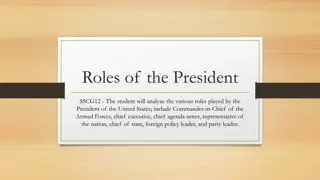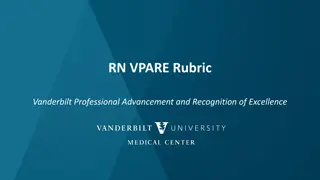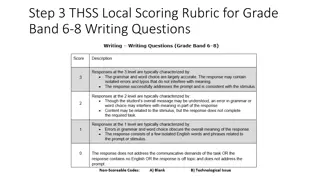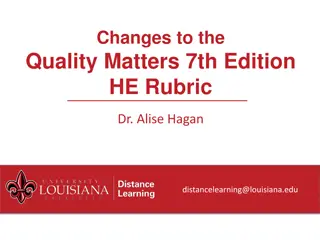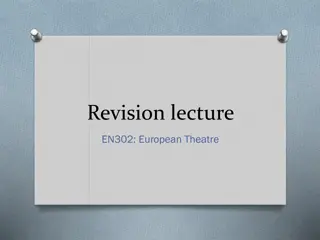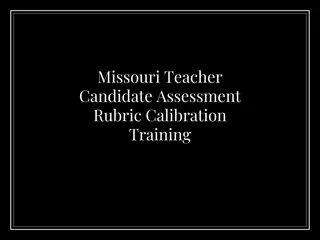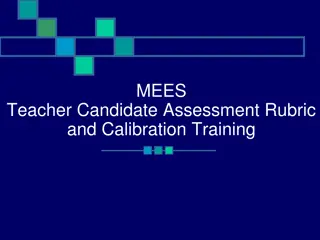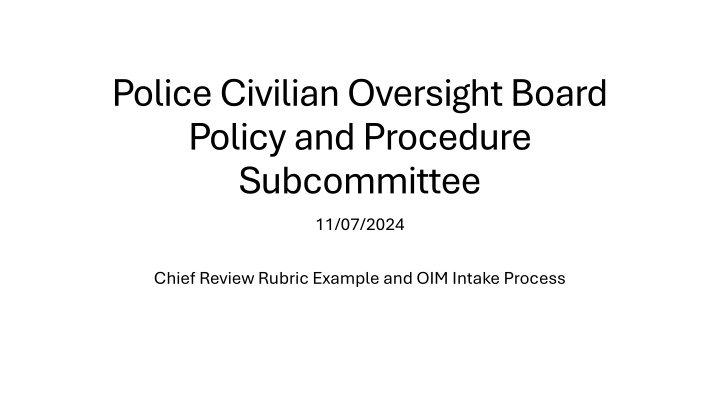
Chief Review Rubric Example and Oversight Process for Effective Leadership
Explore the Chief Evaluation rubric used in Oakland, focusing on leadership qualities over crime statistics. Learn how the evaluation process is administered by the Chief, OIM, and Board members, with ratings ranging from Exceptional to Unacceptable. Additionally, discover the importance of integrity and morale in law enforcement leadership for community trust and effectiveness.
Download Presentation

Please find below an Image/Link to download the presentation.
The content on the website is provided AS IS for your information and personal use only. It may not be sold, licensed, or shared on other websites without obtaining consent from the author. If you encounter any issues during the download, it is possible that the publisher has removed the file from their server.
You are allowed to download the files provided on this website for personal or commercial use, subject to the condition that they are used lawfully. All files are the property of their respective owners.
The content on the website is provided AS IS for your information and personal use only. It may not be sold, licensed, or shared on other websites without obtaining consent from the author.
E N D
Presentation Transcript
Police Civilian Oversight Board Policy and Procedure Subcommittee 11/07/2024 Chief Review Rubric Example and OIM Intake Process
Chief Review Rubric Example The following is a summary of the Chief Evaluation rubric Oakland uses. Their rubric focuses on different aspects of effective leadership rather than city-wide crime statistics, thereby evaluating the Chief specifically rather than the Department.
Administering the Evaluation The Chief independently reviews the different areas of evaluation and self-rates their performance and describes their significant achievements of service for each of the areas. 1. 2. The OIM reviews the Chief s responses for accuracy, completeness, and relevancy, providing additional context or perspective from the OIM next to the Chief s answers. The OIM provides details, not a score. 3. The Board reviews the Chief s responses and the Monitor s notations, then meets with the Chief in closed session to discuss any topics in further detail. Finally, each board member present for the review enters their own scores for each of the areas. Board members may include written comments to supplement their scores. The Board members scores in each areas are averaged for each area of the evaluation. 4. The Chief s self-scores and the Board s average scores are then presented next to each other, along with the Chief s responses, the OIM s comments, and the Board s (anonymized) scores and comments. A final version of the report is made available to the Common Council, Mayor, and Public.
Rating scale 1. Exceptional Exceptional Performance consistently exceeds standards and requirements. Achievements are well beyond those normally expected of someone in the job. This is a level reserved for individuals whose performance has been consistently excellent. 2. Commendable Commendable Performance is clearly above normal expectations for the position. Individuals with solid experience and well-developed skills usually achieve this level. 3. Acceptable Acceptable Meets or occasionally exceeds the expected standards, usually able to perform without close supervision. Consistently satisfactory performance. Achievement is at a level normally expected for an individual in the job. 4. Needs improvement Needs improvement Performance is inconsistent and may be satisfactory sometimes and unacceptable at others. The individual often needs close supervision, guidance, and direction. This level typically describes and individual who needs to show improvement and requires further development. 5. Unacceptable Unacceptable Performance consistently does not meet standards and expectations.
Integrity/High Moral Character Law enforcement agencies should acknowledge the role of policing in past and present injustice and discrimination and how it is a hurdle to the promotion of community trust. (President s Task Force on 21st Century Policing). Community trust and the legitimacy of professional policing hinges on leadership with deep integrity, strong morals, and honesty. + Provide the Board regular updates as to the progress of your published five- year strategic plan + Demonstrate a commitment to rebuilding trust with Madison s youth through specific programs, campaigns, and strategies + Develop, integrate, and track restorative and procedural justice programs + Explore and adopt successful trust-building programs from other cities
Service Delivery & Leadership A strong balance must be established between serving the people and goals of the organization. Shared, distributed leadership serves the goal of service leadership by propagating power sharing at every organizational level. + Deliver safety and crime prevention in Madison, prioritizing violent crimes and serious risks to public safety. + Plan, direct, supervise, and coordinate the activities of MPD personnel in serving the public, preserving order, protecting life and property, and enforcing laws. + Seek out, craft, and implement modern, progressive police management methods. + Promote de-escalation and disengagement tactics + Take measures to demilitarize the police force. + Ensure a safe and supportive work environment and a fair and inclusive culture in support of healthy staff morale
Visionary & Innovative Leadership Leadership requires a focus on the attainment of a clearly communicated future end- state, a shared vision that is not only understandable but innovative and unhampered by the constraints of the present. Visionary leaders co-create the evolution of the community they serve. The Chief must clearly communicate a future end-state for the Department he helms + Develop and begin to implement long-term initiatives that empower the Department to deliver the police services Madison will need in the future. + Identify benchmark jurisdictions and overhaul training and professional development programs to represent and exceed national best practice as it currently stands. + Craft and implement employee development plans ensuring equitable performance paths are known and understood + Maintain a whistleblower program promoting the spirit of accountability with the Department
Adaptive Leadership Adaptive leaders are resourceful; they orchestrate teams toward collaborative solutions as they arise. This must also include the ability to evolve (long-term adaptation). As the needs of the city, residents and communities served continue to evolve, the agency and its leadership must evolve with it. The Chief must exhibit adaptability, as problems arise that are not fully covered by pre-established responses. + Exhibit resourcefulness in the face of new challenges + Orchestrate teams toward collaborative solutions as they arise. + Develop a shared, distributed leadership model that propagates power sharing. + Show ways the Department has or intends to shift and evolve to support the evolving needs of Madison + Renew, revise, or develop a recruitment/retention strategy to address local and national trends that influence policing + Develop, train, mentor, and elevate a diverse leadership team and leadership pipeline to support the Chief s vision for the future of the Department
Transparent Leadership (Communication) Leadership requires clear, consistent, and transparent communication and the ability to do so with increasingly diverse stakeholders, oftentimes struggling with trauma. A transparent leader s communication style should be timely, direct, and comprehensive, while conveying competence, authority, and empathy. The Chief must exemplify clear, consistent, and transparent communication with a range of key, diverse stakeholders. + Communicate in a timely, direct, and comprehensive manner, while conveying competence, authority, and empathy. + Continue to professionalize and expand MPD s ongoing use of social media. + Develop and implement channels for public awareness and engagement to ensure broad community voices are heard, and ensure that appropriate action is taken when the Department obtains feedback and community information through these channels + Identify and commit to leadership training and development
Relational Leadership The acknowledgement that no one person or agency can be solely responsible for solving any problem emphasize the critical need for strong partnerships and the ability to foster and deepen relationships. This requires high emotional intelligence as well as compassionate, consistent, equity-focused professionalism with all stakeholders. The Chief must create and maintain strong, key relationships with a wide range of peers in government and stakeholders in community. + Exemplify high emotional intelligence as well as compassionate, consistent, equity- focused professionalism with all stakeholders. + Forge effective professional relationships with the City departments as well as with other local, state, and federal public safety officials and organizations. + Cultivate positive community relations through sustained, in person interaction with diverse neighborhoods and civic and community groups. + Grow your professional network - as well as the Department's - through formal and informal partnerships
Sustainability Leadership Sustainability Leadership is critical to the long-term success of the agency and the community it serves. Human and environmental impacts of an organization should be paramount to its forward visioning, including the health and well-being of the Madison Police Department. As the culture keeper of an organization, the leader must model personal sustainability and encourage the same in others. A deep focus on a humanizing culture of equity is foundational to the sustainability of a justice- centered community. The Chief must prioritize the long-term sustainability of the Department and the community MPD serves. By sustainable, we mean meeting the needs of the present without compromising the ability of future generations to meet their own needs. + Renew MPD s commitment to sustainability: including racial justice, environmental justice, and a fair, equitable, and humanizing workplace culture. + Promote policies and rules that support the mental and emotional health and well-being of MPD s officers and civilian staff. + Understand and address the human and environmental impacts of MPD, including the health and well-being of the force. + Implement updated policies related to bias and discrimination + Ensure trainings related to topics concerning equity are modern, comprehensive, and conducted regularly. + Identify and commit to leadership training and development programs + Connect and work with other City leaders and experts
Culture Transformation The business of policing has been changing and must continue to do so if our communities are expected in rely on and trust PDs to protect and serve. It is imperative that the Department continues to adopt and display a guardian mindset, be ready and brave enough to hold itself accountable, and do the work necessary to strengthen the community s trust. Sustainable cultural change cannot happen overnight, but requires diligence, creativity, empathy, and persistence if the relationship between law enforcement agencies and the communities they serve is ever to improve. The Chief must foster a culture of self-examination and constant improvement within the Department. + Serve as a model leader who is communicative, confident, collaborative, and decisive, with sensitivity, political acumen, good judgment, astute environmental awareness, strong professional presence, and an inspiring demeanor. + Promote fair, principled, and accountable policing. + Support a whistleblower program promoting the spirit of accountability with the Department, that ensures officers can report misconduct safely.
Discussion and Next Steps Areas of focus? Too many? Too few? Etc. Specific examples? Measurable and clear examples/calls to action for the Chief Scoring? Additional input beyond MPD, OIM, PCOB? Some jurisdictions have made use of public polls and surveys to gather input from other stakeholders. I will bring an updated draft to the next P&P Subcommittee (12/5) for approval, integrating input I receive both from the Board and any members of the public that wish to share their thoughts with me at oim@cityofmadison.com
OIM Intake Process Urgency factors: Prioritization Formula Categories (code) Potential for evidence degradation (1 to 5) Age of incident (1 to 5) Heightened public interest (1 to 5) P = C x U = M x t / T Deadly Use of Force (95) Use of Force (90) Racial Profiling (80) Discrimination (70) Ethical/Procedural Misconduct (60) Discourtesy (50) Policy Failure (40) Policy Success (30) MPD Staff Praise (20) General Public Input (10) P = Priority C = Category code U = Urgency, calculated through sum of urgency factors, scored 1 to 5 each, with 5 being the highest level of urgency for each factor [YY]-[CC]-[sequential number] Example of Numbering Intake with multiple allegations Example of Numbering Intake with multiple allegations 24-70-0001 (PO stop/search of person wearing UW hat) 24-40-0001 (MPD s policy is UW hats are associated with local gang and wearing UW hat is PC for search) 24-10-0001 (MPD s UW apparel policy doesn t make sense)



